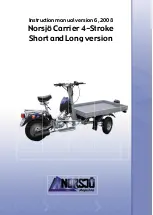
Section 8 – Inspection, Service & Maintenance
R6 3/30/2017
Page 59
8.2 I
NSPECTION AND
S
ERVICE
I
NSTRUCTIONS
8.2.1
Axle Bolts, Frame, Suspension, &
Structure
^ WARNING
Worn or broken suspension parts can
cause loss of control and injury may result.
Have trailer professionally inspected
annually and after any impact.
To perform many of the inspection and maintenance
activities, you must jack up the trailer. Figure 8-1
indicates the general areas where jacks and jack
stands may be applied.
When jacking and using jack stands, place them so
as to clear wiring, brake lines, and suspension parts
(springs, torsion bars, etc.). Place jacks and jack
stands inside of the perimeter strip on the
supporting structure to which the axles are attached.
Jacking Points for Trailer – Figure 8-1
^ WARNING
Never crawl under your trailer unless it is
on firm and level ground and resting on
properly placed and secured jack stands.
8.2.2 Trailer Structure
Wash the entire trailer thoroughly immediately after
exposure to road salt and liquid deicer. The salt
and liquid deicer will corrode and pit the aluminum.
Because the trailer floor receives the most abuse, it
will most likely corrode before any other part of the
structure. This is particularly true for horse and
livestock trailers, having floors subjected to urine
and manure. The urine and manure are corrosive to
the aluminum flooring and other structural parts of
the trailer.
Remove the rubber mats from the floor of the
trailer, and wash them, at least every three
months.
Using a power washer and a detergent
solution, wash both sides of the rubber mat, as well
as the floor and walls of the trailer. Rinse the
rubber mat and the trailer floor and walls. Be sure
the rubber mat and trailer floor are completely dry
before replacing the rubber mat.
8.2.2.a Fasteners and Frame Members
Inspect all of the fasteners and structural frame
members for bending and other damage, cracks, or
failure. Repair or replace any damaged fastener and
repair the frame member. If you have any questions
about the condition or method of repair of fasteners
or frame members, get the recommendation of, or
have the repair done by, your dealer.
The various fastener types used on your trailer are:
•
Bolts, which are used mainly for attaching door
and gate hinges to the trailer body;
•
Buck Rivets, which are used to attach the sides
and roof panels of the body to each other, and
to the frame of the trailer; and
•
Huck Bolts may be at various locations on the
sub-frame. See figure 8-2. Huck bolts are not
user serviceable. If you detect a loose huck bolt
fastener, do not tow the trailer. Call your dealer
for instructions.
Typical Huck Bolt Locations – Figure 8-2
Summary of Contents for Horse Trailer
Page 1: ...OWNER S MANUAL ENCLOSED TRAILERS...
Page 4: ......














































